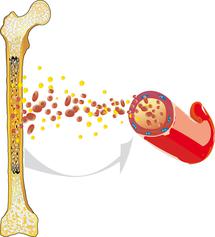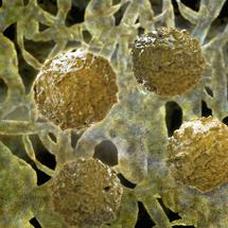Bone marrow – where blood is made
Author: Maria Yiallouros, Editor: Maria Yiallouros, English Translation: PD Dr. med. Gesche Tallen, Last modification: 2017/03/01 https://kinderkrebsinfo.de/doi/e261379
Blood cells are formed in the bone marrow.
The bone marrow is a spongy, heavily perfused tissue inside many bones (such as the vertebrae, hip and leg bones, ribs, shoulder and collarbone, to name a few).
The blood cells, known as red and white blood cells as well as platelets, arise in the bone marrow from one common cell, the so-called blood stem cell (multipotential haematopoietic stem cell). Early in blood cell development, this stem cell forms a common myeloid and a common lymphoid progenitor cell, from which the myeloid and lymphoid, and following subsequent blood cell lines arise:
red blood cells, platelets and some of the white blood cells (granulocytes, monocytes) arise from the common myeloid progenitor cell
lymphocytes, which are another subgroup of the white blood cells, arise from the common lymphoid progenitor cell.
Every stem or progenitor cell, respectively, can produce many millions of descendants. These different blood cells mature in the bone marrow and as soon as they are fully functional, they all enter circulation – except the lymphocytes, a subset of white blood cells. They also mature in the lymphatic organs (such as lymph nodes, spleen, tonsils, thymus and mucous membranes of the intestines).
Mature blood cells have a relatively short life-span: platelets and white blood cells live only eight to twelve days, red blood cells last for 120 days. As a consequence, the overall consumption of blood cells is huge: every second, more than two million blood cells perish – billions every day.
Hence, in order to provide enough blood cells to fulfill vital chores, the bone marrow must continuously produce resupply. In healthy individuals, this balance is kept very well: the bone marrow produces as many cells as have perished, and certain inhibitory factors prevent „overproduction“.
Impaired blood formation, as, for example, seen in patients with blood cancer (leukaemias) can be detected by specific bone marrow tests.


